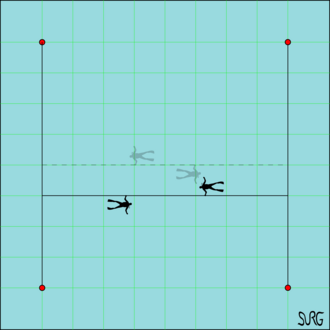Underwater searches






Underwater searches are operations conducted to locate objects or individuals submerged in bodies of water. These searches are often carried out by specialized teams using a variety of techniques and equipment to ensure thorough and efficient exploration of underwater environments.
Techniques and Equipment[edit]
Underwater searches employ several techniques and equipment, including:
- Sonar: Utilized to detect objects underwater by emitting sound waves and interpreting the echoes that bounce back.
- Diving: Professional divers are often deployed to visually inspect areas that are difficult to reach with equipment alone.
- ROVs: These are unmanned, remotely controlled submersible vehicles equipped with cameras and sensors.
- Side-scan sonar: A specialized sonar system used to create detailed images of the sea floor.
- Magnetometer: Used to detect metal objects underwater by measuring magnetic fields.
- Underwater cameras: High-resolution cameras that can capture images and videos in low-light conditions.
Applications[edit]
Underwater searches are conducted for various purposes, including:
- Search and rescue: Locating individuals who have gone missing underwater.
- Salvage operations: Recovering valuable objects or wreckage from the seabed.
- Underwater archaeology: Exploring and documenting submerged historical sites and artifacts.
- Environmental monitoring: Assessing the health of underwater ecosystems and detecting pollution.
- Military operations: Locating and neutralizing underwater mines or other threats.
Challenges[edit]
Conducting underwater searches presents several challenges:
- Visibility: Poor visibility due to murky water or low light conditions can hinder search efforts.
- Depth: The deeper the search area, the more complex and dangerous the operation becomes.
- Currents: Strong underwater currents can displace objects and pose risks to divers and equipment.
- Pressure: Increased pressure at greater depths requires specialized equipment and training.
Notable Underwater Searches[edit]
Some notable underwater searches include:
- The search for the wreckage of Malaysia Airlines Flight 370.
- The recovery of artifacts from the Titanic.
- The exploration of the Antikythera mechanism site.
Related Pages[edit]
- Sonar
- Diving
- Remotely Operated Vehicle
- Search and rescue
- Underwater archaeology
- Environmental monitoring
- Military operations
| Search and rescue operations | ||||||||
|---|---|---|---|---|---|---|---|---|
This search and rescue related article is a stub.
|
| Diving | ||||||||||
|---|---|---|---|---|---|---|---|---|---|---|
This diving-related article is a stub.
|
This marine-related article is a stub. You can help WikiMD by expanding it.
Ad. Transform your life with W8MD's Budget GLP-1 injections from $75


W8MD offers a medical weight loss program to lose weight in Philadelphia. Our physician-supervised medical weight loss provides:
- Weight loss injections in NYC (generic and brand names):
- Zepbound / Mounjaro, Wegovy / Ozempic, Saxenda
- Most insurances accepted or discounted self-pay rates. We will obtain insurance prior authorizations if needed.
- Generic GLP1 weight loss injections from $75 for the starting dose.
- Also offer prescription weight loss medications including Phentermine, Qsymia, Diethylpropion, Contrave etc.
NYC weight loss doctor appointmentsNYC weight loss doctor appointments
Start your NYC weight loss journey today at our NYC medical weight loss and Philadelphia medical weight loss clinics.
- Call 718-946-5500 to lose weight in NYC or for medical weight loss in Philadelphia 215-676-2334.
- Tags:NYC medical weight loss, Philadelphia lose weight Zepbound NYC, Budget GLP1 weight loss injections, Wegovy Philadelphia, Wegovy NYC, Philadelphia medical weight loss, Brookly weight loss and Wegovy NYC
|
WikiMD's Wellness Encyclopedia |
| Let Food Be Thy Medicine Medicine Thy Food - Hippocrates |
Medical Disclaimer: WikiMD is not a substitute for professional medical advice. The information on WikiMD is provided as an information resource only, may be incorrect, outdated or misleading, and is not to be used or relied on for any diagnostic or treatment purposes. Please consult your health care provider before making any healthcare decisions or for guidance about a specific medical condition. WikiMD expressly disclaims responsibility, and shall have no liability, for any damages, loss, injury, or liability whatsoever suffered as a result of your reliance on the information contained in this site. By visiting this site you agree to the foregoing terms and conditions, which may from time to time be changed or supplemented by WikiMD. If you do not agree to the foregoing terms and conditions, you should not enter or use this site. See full disclaimer.
Credits:Most images are courtesy of Wikimedia commons, and templates, categories Wikipedia, licensed under CC BY SA or similar.
Translate this page: - East Asian
中文,
日本,
한국어,
South Asian
हिन्दी,
தமிழ்,
తెలుగు,
Urdu,
ಕನ್ನಡ,
Southeast Asian
Indonesian,
Vietnamese,
Thai,
မြန်မာဘာသာ,
বাংলা
European
español,
Deutsch,
français,
Greek,
português do Brasil,
polski,
română,
русский,
Nederlands,
norsk,
svenska,
suomi,
Italian
Middle Eastern & African
عربى,
Turkish,
Persian,
Hebrew,
Afrikaans,
isiZulu,
Kiswahili,
Other
Bulgarian,
Hungarian,
Czech,
Swedish,
മലയാളം,
मराठी,
ਪੰਜਾਬੀ,
ગુજરાતી,
Portuguese,
Ukrainian